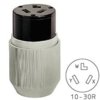So maybe I'm thinking about this incorrectly....so please help me out. I've been researching extension cords....and stumbled upon the 14-50 adapters. Apparently you can just get 1 extension cord for the 14-50 and just get multiple adapters to all sorts of outlets. They basically just make any outlet adaptable to the 14-50 plug. I originally figured you'd need an extension cord for each outlet...but this 14-50 extension cord seems pretty great, although it seems dubious that voltage and amperage adjust based on the adapter. Have others in the forum used both....or at least 1 option?
My purpose here is mostly in terms of destination charging....with extension cords. In laws have a super old lake house with old dryer plug..which needs extension cord. We also travel to outer banks which has newer outlets or just 120 volt at our rental.
im just looking for the best extension cord or adapter options to be prepared...
lil help.
My purpose here is mostly in terms of destination charging....with extension cords. In laws have a super old lake house with old dryer plug..which needs extension cord. We also travel to outer banks which has newer outlets or just 120 volt at our rental.
im just looking for the best extension cord or adapter options to be prepared...
lil help.



